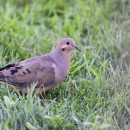
The mourning dove (Zenaida macroura) is one of the most abundant bird species in North America, and is familiar to millions of people. Authority and responsibility for management of this species in the U.S. is vested in the Secretary of the Interior. This responsibility is conferred by the Migratory Bird Treaty Act of 1918 which, as amended, implements migratory bird treaties between the U.S. and other countries. Mourning doves are included in the treaties with Great Britain (for Canada) and Mexico (U.S. Department of the Interior 2013). These treaties recognize sport hunting as a legitimate use of a renewable migratory bird resource. Maintenance of dove populations in a healthy, productive state is a primary management goal. Management activities include population assessment, harvest regulation, and habitat management. Each year, tens of thousands of doves are banded and thousands of wings from harvested doves are analyzed to estimate annual survival, harvest rates, recruitment, and abundance. The resulting information is used by wildlife managers in setting annual hunting regulations (USFWS 2017). Past federal frameworks for hunting mourning doves in the U.S. are in Appendix A.



